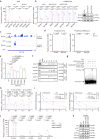The ELAVL3/MYCN positive feedback loop provides a therapeutic target for neuroendocrine prostate cancer
- PMID: 38016952
- PMCID: PMC10684895
- DOI: 10.1038/s41467-023-43676-3
The ELAVL3/MYCN positive feedback loop provides a therapeutic target for neuroendocrine prostate cancer
Abstract
Neuroendocrine prostate cancer is a rapidly progressive and lethal disease characterized by early visceral metastasis, poor prognosis, and limited treatment options. Uncovering the oncogenic mechanisms could lead to the discovery of potential therapeutic avenues. Here, we demonstrate that the RNA-binding protein ELAVL3 is specifically upregulated in neuroendocrine prostate cancer and that overexpression of ELAVL3 alone is sufficient to induce the neuroendocrine phenotype in prostate adenocarcinoma. Mechanistically, ELAVL3 is transcriptionally regulated by MYCN and subsequently binds to and stabilizes MYCN and RICTOR mRNA. Moreover, ELAVL3 is shown to be released in extracellular vesicles and induce neuroendocrine differentiation of adenocarcinoma cells via an intercellular mechanism. Pharmacological inhibition of ELAVL3 with pyrvinium pamoate, an FDA-approved drug, effectively suppresses tumor growth, reduces metastatic risk, and improves survival in neuroendocrine prostate cancer mouse models. Our results identify ELAVL3 as a critical regulator of neuroendocrine differentiation in prostate cancer and propose a drug repurposing strategy for targeted therapies.
© 2023. The Author(s).
Conflict of interest statement
The authors declare no competing interests.
Figures








Similar articles
-
Targeting the MYCN-PARP-DNA Damage Response Pathway in Neuroendocrine Prostate Cancer.Clin Cancer Res. 2018 Feb 1;24(3):696-707. doi: 10.1158/1078-0432.CCR-17-1872. Epub 2017 Nov 14. Clin Cancer Res. 2018. PMID: 29138344 Free PMC article.
-
Activated ALK Cooperates with N-Myc via Wnt/β-Catenin Signaling to Induce Neuroendocrine Prostate Cancer.Cancer Res. 2021 Apr 15;81(8):2157-2170. doi: 10.1158/0008-5472.CAN-20-3351. Epub 2021 Feb 26. Cancer Res. 2021. PMID: 33637566 Free PMC article.
-
CHRM4/AKT/MYCN upregulates interferon alpha-17 in the tumor microenvironment to promote neuroendocrine differentiation of prostate cancer.Cell Death Dis. 2023 May 4;14(5):304. doi: 10.1038/s41419-023-05836-7. Cell Death Dis. 2023. PMID: 37142586 Free PMC article.
-
Targeting PKLR/MYCN/ROMO1 signaling suppresses neuroendocrine differentiation of castration-resistant prostate cancer.Redox Biol. 2023 Jun;62:102686. doi: 10.1016/j.redox.2023.102686. Epub 2023 Mar 21. Redox Biol. 2023. PMID: 36963289 Free PMC article.
-
Targeting Key Players of Neuroendocrine Differentiation in Prostate Cancer.Int J Mol Sci. 2023 Sep 5;24(18):13673. doi: 10.3390/ijms241813673. Int J Mol Sci. 2023. PMID: 37761978 Free PMC article. Review.
Cited by
-
High cereblon expression in neuroendocrine cancer confers vulnerability to GSPT1 molecular glue degrader.Exp Hematol Oncol. 2025 Jun 23;14(1):89. doi: 10.1186/s40164-025-00674-z. Exp Hematol Oncol. 2025. PMID: 40551250 Free PMC article.
-
Regulatory mechanisms of the Hippo/YAP axis by G-protein coupled estrogen receptor in gastric signet-ring cell carcinoma.Neoplasia. 2025 Sep;67:101199. doi: 10.1016/j.neo.2025.101199. Epub 2025 Jun 23. Neoplasia. 2025. PMID: 40554953 Free PMC article.
-
SNAI1 promotes epithelial-mesenchymal transition and maintains cancer stem cell-like properties in thymic epithelial tumors through the PIK3R2/p-EphA2 Axis.J Exp Clin Cancer Res. 2024 Dec 19;43(1):324. doi: 10.1186/s13046-024-03243-0. J Exp Clin Cancer Res. 2024. PMID: 39702326 Free PMC article.
-
A high-throughput screening platform to identify MYCN expression inhibitors for liver cancer therapy.Front Oncol. 2025 Feb 14;15:1486671. doi: 10.3389/fonc.2025.1486671. eCollection 2025. Front Oncol. 2025. PMID: 40027135 Free PMC article.
-
Allosteric targeted drug delivery for enhanced blood-brain barrier penetration via mimicking transmembrane domain interactions.Nat Commun. 2025 Apr 10;16(1):3410. doi: 10.1038/s41467-025-58746-x. Nat Commun. 2025. PMID: 40210849 Free PMC article.
References
Publication types
MeSH terms
Substances
Associated data
- Actions
- Actions
- Actions
- Actions
Grants and funding
LinkOut - more resources
Full Text Sources
Medical
Molecular Biology Databases
Research Materials
Miscellaneous

